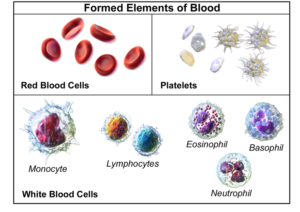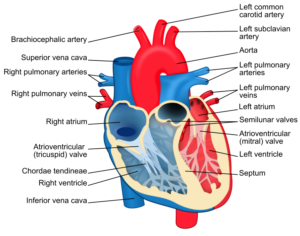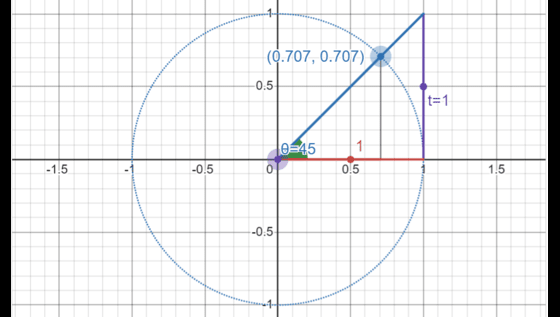There are multiple organ systems in the human body that work together to keep us alive. One of these systems is the circulatory system. The major components of the circulatory system are blood, blood vessels, and the heart. The main function of the circulatory system is to transport nutrients and gases throughout the body so cells can be provided with the nutrients and gases they need to function. It does this using blood and blood vessels, which act as a transportation network. Blood is made up of several components:
 Plasma (55%) – carries nutrients, hormones, waste products, and blood cells
Plasma (55%) – carries nutrients, hormones, waste products, and blood cells
Red Blood Cells (44%) – contains hemoglobin, a protein that is iron rich, and allows for the red blood cells to carry oxygen
White Blood Cells (<1%) – part of the body’s immune system. They help to defend against infection and disease
Platelets (<1%) – responsible for blood clotting (thickening). This helps to prevent blood loss at the site of wounds.
Blood is contained inside the body in blood vessels. If you can imagine the body as a house, and blood as water, then blood vessels are the pipes carrying water throughout the home.
Types of Blood Vessels
Arteries – Carry blood that’s being pumped AWAY from the heart. This blood is under high pressure, and so arteries have thick, muscular walls.
Veins – Carry blood TO the heart. They contain valves which prevent the blood from flowing backwards. Veins have thinner walls than arteries as they are not under as much pressure.
Capillaries – Connect arteries and veins. They are very thin, and have walls made of epithelial tissue one cell layer thick. Because their walls are so thin, nutrients and gases can diffuse (travel) in and out of them. Capillaries can be found with alveoli (in the lungs; part of the respiratory system), and with the villi (in the stomach, part of the digestive system)
The Heart
 The heart is another important component of the circulatory system. It is the pump that provides the pressure to help move blood throughout the blood vessels and around the body. Veins move blood into the heart. The blood that is brought to the heart by veins is lacking in oxygen, as it has been transferred to the body’s cells. Blood is first moved into the right atrium, and then pumped to the right ventricle. Afterwards, the blood is pumped via the pulmonary artery to the lungs, where the blood can be oxygenated. The oxygenated blood then returns to the heart via veins from the lungs, into the left atrium. Then, the blood is pumped into the left ventricle and out through the aorta, where it can then be transported throughout the rest of the body. The valves in the heart prevent the blood from
The heart is another important component of the circulatory system. It is the pump that provides the pressure to help move blood throughout the blood vessels and around the body. Veins move blood into the heart. The blood that is brought to the heart by veins is lacking in oxygen, as it has been transferred to the body’s cells. Blood is first moved into the right atrium, and then pumped to the right ventricle. Afterwards, the blood is pumped via the pulmonary artery to the lungs, where the blood can be oxygenated. The oxygenated blood then returns to the heart via veins from the lungs, into the left atrium. Then, the blood is pumped into the left ventricle and out through the aorta, where it can then be transported throughout the rest of the body. The valves in the heart prevent the blood from
flowing backwards.
The circulatory system transports nutrients and gases throughout the body. Without it, the body’s cells would be without what they need to survive. One of the diseases that affects the circulatory system is high blood pressure or hypertension. Blood pressure is the pressure or force of blood as it flows through the circulatory system. Blood pressure is related to the volume of blood, heart rate, artery size and elasticity, and blood viscosity.
High Blood Pressure
Having high blood pressure puts strain on the heart because it’s forced to beat more rapidly. This can cause the heart to get bigger and become less efficient over time. One factor that can increase the risk of high blood pressure is a poor diet. High fat diets can cause the buildup of cholesterol in the arteries, which can cause them to become narrowed and blocked. As there is now less space for the blood to flow through (ie. artery is less wide), blood pressure increases.
In conclusion, the circulatory system’s main function is to transport nutrients and gases around the body via blood and blood vessels. The heart provides the pumping action to move the blood around. One disease of the circulatory system is high blood pressure, where the pressure of blood in blood vessels is higher than normal.
SchoolTutoring Academy is the premier educational services company for K-12 and college students. We offer tutoring programs for students in K-12, AP classes, and college. To learn more about how we help parents and students in Aloha, Oregon visit: Tutoring in Aloha, Oregon.




